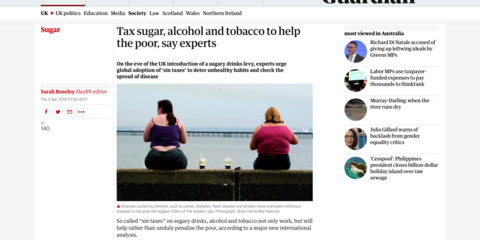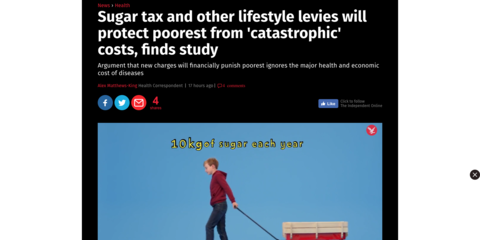
Taxes on soft drinks, alcohol and tobacco are a powerful response to rising rates of chronic diseases
Taxes on soft drinks, alcohol and tobacco are a powerful response to rising rates of non-communicable diseases (NCDs) worldwide, according to the most comprehensive analysis to date of evidence on expenditure, behaviour and socio-economic status, published today in The Lancet.
Bringing together data from across the globe, the five papers, including one led by The George Institute for Global Health, present strong evidence that taxes on unhealthy products have the potential to produce major health gains among the poorest in society who are disproportionately affected by NCDs. The evidence helps counter fears that such taxes will necessarily disproportionately harm the poor.
Non-communicable diseases such as cancer, heart disease and diabetes are responsible for 38 million deaths each year. The Sustainable Development Goal NCD target (SGD 3.4) is to reduce deaths from NCDs by a third by 2030 and promote mental health.
“Non-communicable diseases are a major cause and consequence of poverty worldwide,” says Dr Rachel Nugent, RTI International (Seattle, USA) and Chair of The Lancet Taskforce on NCDs and economics. “Responding to this challenge means big investments to improve health care systems worldwide, but there are immediate and effective tools at our disposal. Taxes on unhealthy products can produce major health gains, and the evidence shows these can be implemented fairly, without disproportionately harming the poorest in society.”
Worldwide, non-communicable diseases are major drivers of poverty
High quality evidence from 283 international studies including data from India, China and Brazil, shows that low socio economic status is consistently associated with higher rates of non-communicable disease in low and middle income countries.
Furthermore, evidence from 66 international studies on 13 chronic diseases, concludes that NCDs place a substantially higher economic burden on low income households compared to higher income households, especially in the absence of health insurance. Uninsured patients experienced a 2-7 fold increase in the odds of catastrophic health spending2 compared with insured patients.
Even with protective health insurance, high levels of co-pays or a lack of coverage for specific treatments mean households can often experience catastrophic expenditure. In China, for example, 1 in 3 patients (37%) with stroke are impoverished from paying for medical treatment and even among people with health insurance, over half (53%) experienced financial catastrophe.
“Poverty and economic hardship have many causes, but this major body of evidence highlights the ruinous and long-term economic burdens of non-communicable diseases on households. An important policy response is to provide financial protection through tax-financed health care and social health insurance programmes, and within these programmes, provide for the subsidisation of interventions that are cost-effective,” said Professor Stephen Jan, of The George Institute for Global Health, lead author of the paper; Action to address the household economic burden of non-communicable diseases.
In a linked Comment, Dr Tedros Adhanom Ghebreyesus, Director General of the WHO, writes: “Every year, almost 100 million people are pushed into extreme poverty because of out-of-pocket health spending, and the costs of treating NCDs are a major contributor to this global scandal. Nobody should lack access to health services because they cannot afford to pay. Failing to provide adequate coverage for NCDs can widen inequities not only in health, but in all other social and economic domains.”
Taxes can produce major health gains for poorest in society
By analysing consumption patterns, expenditure and responsiveness to price changes across different income groups, the Taskforce provides a comprehensive analysis of existing data to help governments understand the potential impact of taxes, and inform whether their use is justified.
Firstly, evidence shows that high income households generally consume more, and spend more, on alcohol, soft drinks and snacks, compared to low income households. Patterns for tobacco are less consistent. In India, for instance, wealthier households spent seven times more on alcohol and three times more on soft drinks and snacks compared to poorer households.
Increased taxes on unhealthy products will therefore affect a larger number of high-income households than low-income households.
The analysis also shows that low income households respond to price changes more readily than higher income households.
In the UK, the response to the possible introduction of a minimum price for alcohol was estimated to be 7.6 times larger in the poorest households, compared to the wealthiest. In Mexico, the introduction of a soft drinks tax resulted in an average of 4.2L less of soft drinks purchased per person, with a 17% decrease in purchases among lower income groups, and almost no change in higher income groups.
Prevention and treatment of non-communicable diseases is central to achieving many of the SDGs
Progress on non-communicable diseases will have a central role in determining the success of at least nine of SDG targets. The SDG target on NCDs (SDG 3.4) links to targets on reducing poverty (SDG 1), hunger (SDG 2), improving health and wellbeing (SDG 3), education (SDG 4), gender equality (SDG 5), work and economic growth (SDG 8), reduced inequalities (SDG 10), sustainable cities and communities (SDG 11), and sustainable production and consumption (SDG 12).
The economic benefits of investing in NCDs are considerable. Cardiovascular diseases account for nearly half of all NCDs deaths every year (17.7 million). The WHO package of ‘best buys’ includes interventions to reduce smoking and salt intake, and pharmaceutical interventions for the prevention and treatment of ischaemic heart disease and stroke6.
The cost of implementing the package in 20 countries where 70% of cardiovascular deaths occur, is estimated at US$120 million for the period to 2030, equivalent to an additional US$1.50 per person. By 2030, this could prevent 15 million premature deaths, making it almost possible to achieve the SDG target of reducing premature mortality from NCDs by a third by 2030. Importantly, the return of investment is 5.6 for economic returns and 10.9 if social returns are also included.
The Lancet Taskforce on NCDs and economics is a partner of the WHO’s Independent High-Level Commission on NCDs2, and will be launched at the WHO NCD Financing meeting in Copenhagen (9-11 April).
Read the full series of papers at thelancet.com/series/Taskforce-NCDs-and-economics
Notes
- Quotes direct from authors and cannot be found in the text of the articles
- The WHO’s Independent High-Level Commission on NCDs is co-chaired by Sania Nishtar, the Presidents of Finland, Sri Lanka, and Uruguay, and the Minister of Healthcare of the Russian Federation. The additional Commission partnerships are with the Bloomberg Philanthropies Taskforce on Fiscal Policy for Health and Chatham House.
- A formal meta-analysis was impossible because of the variable definitions used – for instance, SES indicators include household and individual income, asset-based and consumption measures and educational attainment.
- Different thresholds for catastrophic health spending have been used. The most common are that out of pocket health care costs comprise over 40% of annual non-subsistence income (household food expenditure) or 30% of total annual income.
- Bangladesh, DR Congo, Myanmar, Egypt, India, Indonesia, Nigeria, Pakistan, Philippines, Ukraine, Vietnam, Brazil, China, Iran, Mexico, South Africa, Thailand, Turkey, Poland and Russia.
- These include interventions to reduce smoking (taxes, advertising bans, health warnings, indoor smoking ban), reducing salt intake (reformulation, labelling, mass media campaigns, low salt meals in public institutions), and pharmaceutical interventions for the prevention and treatment of ischaemic heart disease and stroke.




